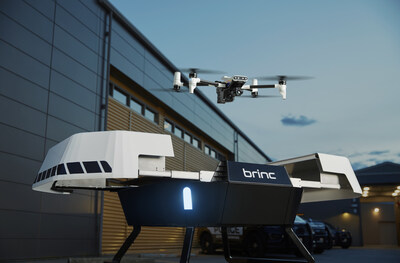BRINC, a pioneer in drone technology for first responders, has officially announced the launch of what will be the first ever purpose-built hardware designed for Drone as First Responder (DFR) operations. Made to reach 911 calls in under 70 seconds, BRINC’s American-made Responder drone can support first responders as part of an agency’s wide automated DFR system, a patrol-led DFR approach, or as a manually deployed drone. In practice, this also involves delivering life-saving payloads, such as EpiPens, automated external defibrillators (AEDs), personal floatation devices (PFDs), and naloxone (Narcan) etc. More on the technology would reveal how it is given a Full HD, 40x zoom visual camera array, and a 640px thermal sensor. Having referred to the thermal sensor, it markedly comes bearing ability to aid firefighters in identifying hotspots during structure fires, and at the same time, supplement search and rescue teams’ efforts of locating missing or injured individuals. Next up, we have a two-way communication capability. This particular capability should be able to facilitate seamless instructions, and therefore, enhance de-escalation during tense confrontations. Then, there is an assortment featuring emergency response vehicle livery, custom agency markings, red and blue lights, and an integrated siren, all of it basically designed to make the system identifiable as a public safety asset.
“The launch of BRINC DFR marks a pivotal moment in the evolution of emergency response. Our DFR initiative is set to revolutionize the public safety landscape by empowering first responders with capabilities that significantly improve emergency response times and outcomes.” said Blake Resnick, Founder & CEO of BRINC.
Moving on, users of BRINC’s latest brainchild can further expect to access a dedicated Responder Station, which happens to be a robotic charging nest designed to be placed throughout communities for fast response times. Besides that, such a feature can also come in handy when the agenda is to ensure that Responders remain operational, protected from weather, and ready to spring into action at a moment’s notice. In practice, the stated component translates to a sub-5-second drone deployment, and once the job is done, the drone can return to the nearest available station and charge itself back to 100% in no more than 40 minutes.
Another detail worth a mention here would be how the entire solution is powered by BRINC LiveOps, a drone operations software platform available on all modern web browsers. The latter detail, like you can guess, allows for easy access on mobile devices, tablets, mobile data computers, and at real-time crime centers. Talk about the LiveOps platform on a slightly deeper level, it brings forth teleoperation capabilities that help you, through just a browser tab and arrow keys, fly Responder drones from anywhere in the world. Furthermore, the platform makes it possible to manage district-wide deployments. Here, you essentially have the option to view calls for service and available drones, select a station to launch from, and quickly deploy drones to emergencies. Joining the same is a set of augmented reality overlays that contextualize live feeds by overlaying map data on drone video. Hold on, there is more, considering we still haven’t discussed the solution’s promise of integrated airspace awareness. The user can achieve this awareness with local weather information, ADS-B data, ground-based radar detections, FAA map tiles, and more.
Among other details, we have a transparency portal, where the technology presents you with flight logs and a program dashboard so to promote transparency. On top of all that, the technology can also integrate with existing computer-aided dispatch (CAD), digital evidence management systems (DEMS), 911 call systems, and more.


